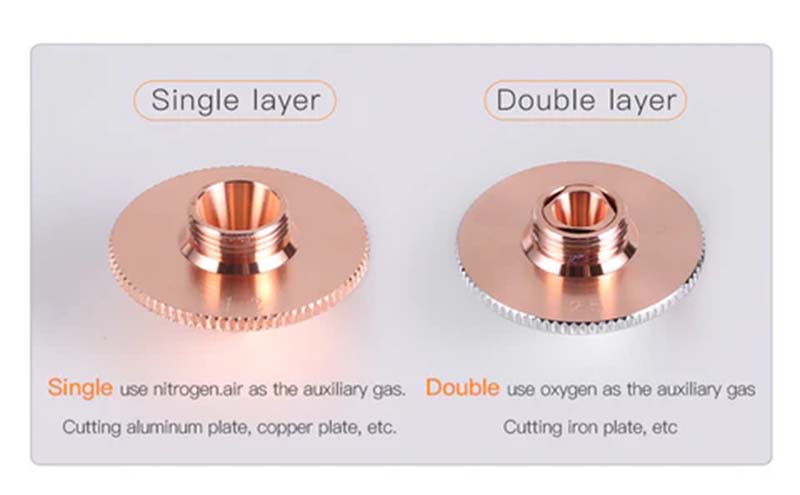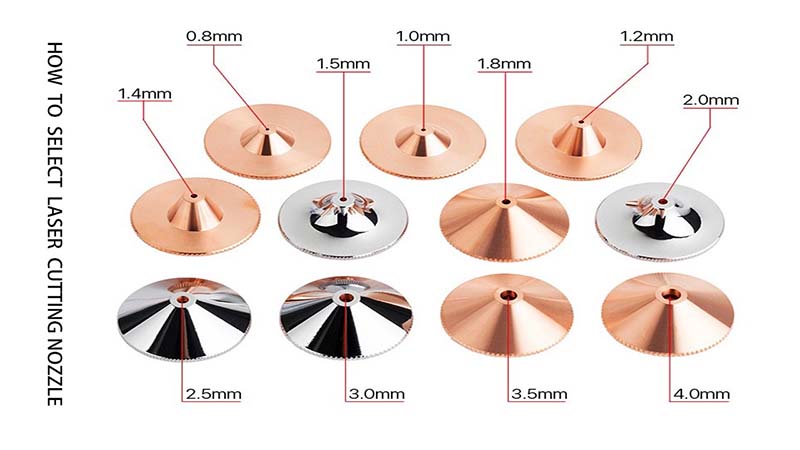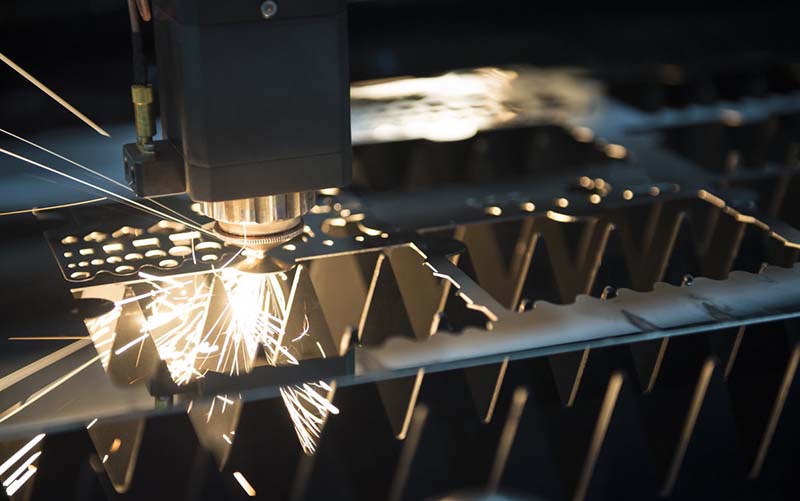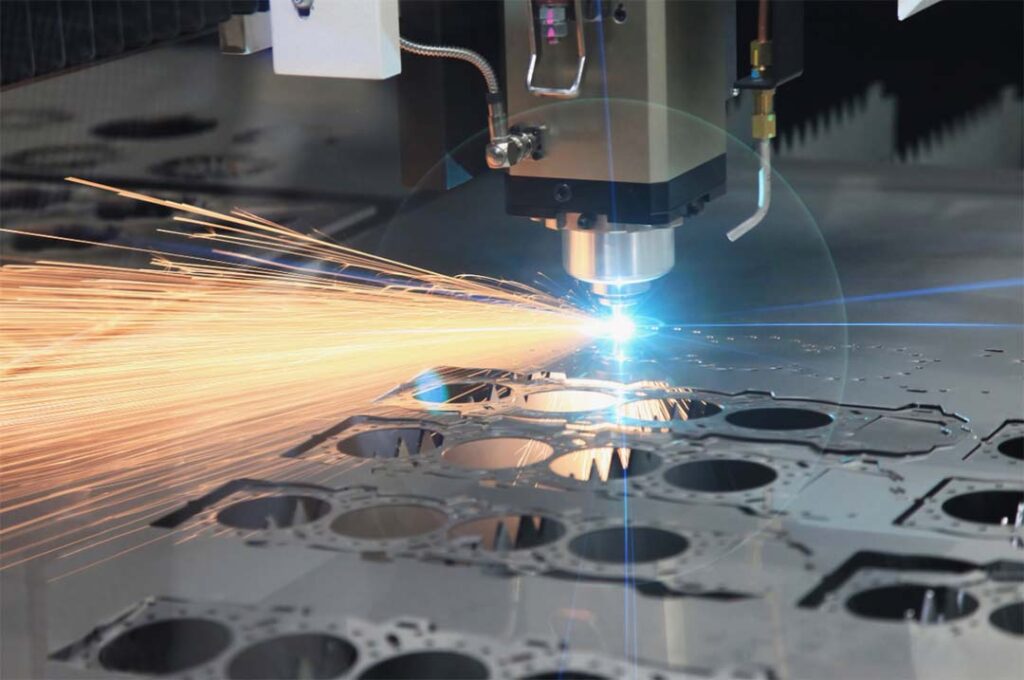Laser cutting machines play a crucial role in sheet metal manufacturing, with the laser cutting nozzle being a key component that directly influences the precision and efficiency of the cutting process. Understanding the features and advantages of different types of nozzles in various applications is essential to ensuring smooth production processes. This article will explore the functions of laser cutting nozzles and how to choose laser cutting nozzles based on specific application requirements.
What is Laser Cutting Machine Nozzles Used For?
The choice of nozzle directly determines the quality of laser cutting. During the laser cutting process, the nozzle is responsible for maintaining the distance between the laser head and the workpiece, guiding assist gases smoothly through the material being cut. It also forms high pressure at the nozzle exit to accelerate cutting speed, remove molten debris, and protect the internal optics of the laser head.
What does the nozzle do on a laser cutter?
Electrode Conduction: The nozzle serves as the collection electrode for capacitance signals, crafted from refined purple copper. This choice leverages purple copper’s excellent electrical conductivity, suitable mechanical strength, and efficient heat transfer capabilities. This material selection ensures lossless transmission of capacitance signals, providing a stable and robust energy foundation for laser cutting.
Airflow Control: Internally designed precision chambers within the nozzle generate directional airflow. This airflow forms a protective barrier in the cutting zone, effectively dispersing molten residue generated during cutting to maintain a clean cutting surface. In oxygen cutting mode, this airflow promotes effective contact between oxygen and metal, accelerating the oxidation reaction (combustion process), significantly enhancing cutting speed and quality.
Laser Head Protection: The nozzle effectively blocks splashing molten material during cutting, preventing it from entering and damaging internal components of the laser head. This reduces maintenance needs and extends equipment lifespan. Considering the protective role of the nozzle, it is essential to avoid removing the nozzle arbitrarily at cutting sites, minimizing exposure of the laser head components to the atmosphere.


What Type of Nozzle is used in Laser Cutting?
Based on the different gases used, nozzles are generally categorized into single-layer and double-layer designs.
Single Layer Laser Nozzle
Single layer nozzles are suitable for cutting thin to medium-thick metal materials, especially thin sheet metal. Single layer nozzles excel in applications where a precise, clean cut is required and are often used where cut quality is critical.
Single-layer nozzles are designed to provide a gentler gas flow, which helps in finely controlling heat distribution during melt-cutting processes. They are suitable for metals like stainless steel, aluminum alloys, and copper, which are sensitive to thermal effects.
Due to these characteristics, single-layer nozzles are often used with nitrogen as the assist gas to achieve good cutting quality and smooth edges while preventing material oxidation.


Double Layer Laser Nozzle
Dual layer nozzles are suitable for cutting thick metals, especially where effective thermal management and high precision are required, such as in the automotive and aerospace industries. Ideally suited to working with metals such as titanium, copper and brass, double layer nozzles excel in applications with complex designs and high quality edges.
Dual layer nozzles, by increasing the gas flow channels, significantly enhance gas exit velocity, thereby creating a stronger airflow in the cutting zone. This structure is particularly suited for oxidation cutting methods.
When cutting high-speed carbon steel and similar materials, double-layer nozzles combined with oxygen assist gas effectively promote surface oxidation reactions, accelerating the cutting process. Although this method may cause slight oxidation and darkening of the cut surface, it remains a highly efficient choice for large-scale carbon steel cutting tasks that prioritize efficiency and cost-effectiveness.
When choosing a copper nozzle for laser cutting, it’s crucial to first determine the material being cut to decide between single-layer or double-layer types. Subsequently, nozzle size should be selected based on laser power and the thickness of the material being processed.
Copper Nozzle Shape
Tapered copper nozzle
This nozzle shape is typically used for cutting tasks that require high precision and smooth edges. The tapered tip facilitates a more focused laser beam and gas flow, which improves cut quality and accuracy, making it ideal for precision cutting and applications that require high edge quality.
Round copper nozzle
Ideal for cutting thicker materials and a variety of general purpose cutting tasks. The cylindrical tip provides a more uniform gas flow that effectively removes molten material generated during the cutting process, helping to maintain cutting efficiency and quality when cutting thick materials.
Laser Cutting Nozzle Selection
The diameter of the nozzle determines the shape of the airflow entering the kerf and the area of gas diffusion, thereby influencing the stability of laser cutting.
A larger nozzle diameter results in greater airflow volume, higher velocity, and proper positioning of the workpiece within the airflow, enhancing the nozzle’s ability to effectively remove molten materials. In theory, as the thickness of the workpiece increases, a larger nozzle diameter, along with higher gas pressure and flow rate, is required to achieve the desired machining surface.
Nozzle diameters typically range from φ1.0mm, φ1.5mm, φ2.0mm, φ2.5mm, to φ3.0mm, with φ1.5mm and φ2.0mm being commonly used. Larger nozzle diameters offer less protection to the focusing lens.


Selection according to cutting thickness
Generally, for sheet thicknesses below 3mm, small diameter nozzle (1.0-1.5 mm): Ideal for cutting thin materials with a fine, focused laser beam. Ideal for tasks that require high precision and delicate cutting, such as the cutting of thin metals or complex patterns.
for 3-10mm metal sheet, the medium-diameter nozzles (1.5-2.5 mm) are suitable for general-purpose cutting tasks in medium-thickness materials. These nozzles offer a good balance between precision and gas flow, and are flexible enough to adapt to a wide range of cutting conditions, making them suitable for a wide range of application scenarios.
For sheet thicknesses above 10mm, large opening diameter nozzles (2.5mm and above) are ideally suited to cutting thicker materials, providing a wider flow of auxiliary gas for effective removal of molten material. Large diameter nozzles increase cutting speed and efficiency in thick materials, helping to reduce the risk of slag formation and effectively removing slag.
Selection according to laser power
Laser power≤6000W
Cutting carbon steel, nozzle specifications for the general diameter of double-layer S1.0 ~ 5.0E;
Cutting stainless steel, the choice of ordinary specifications of single-layer nozzle;
Laser power≥6000W
Cutting carbon steel, 10 ~ 25mm carbon steel bright cutting, selection of cutting nozzle specifications for the general diameter of double-layer S1.2 ~ 1.8E; single-layer fan diameter is generally selected D1.2 ~ 1.8;
Cutting stainless steel, the choice of ordinary specifications of the single-layer nozzle. More detailed nozzle selection details can consult our professional laser equipment engineers.


How to Choose Laser Cutting Nozzles?
Material Selection: A good copper nozzle must be made from T2 copper due to its high electrical conductivity and excellent heat transfer properties, ensuring reliable capacitive signals.
High Processing Precision: A quality laser head nozzle must achieve a concentricity of 0.03mm, with nozzles under 1.0mm in size requiring a concentricity of 0.02mm. High precision concentricity not only reduces preliminary adjustments during processing but also effectively prevents high-energy lasers from striking the inner wall of the laser head, thereby avoiding potential damage.
Highly Polished Laser Head Surface: The laser head nozzle requires a surface roughness of up to 0.8 for both its inner and outer surfaces. A highly polished outer surface reduces molten material adhesion during cutting, extending the nozzle’s lifespan, while a polished inner surface prevents the generation of vortices from high-pressure gas outflow, improving cutting quality and efficiency.
Anti-Oxidation Treatment: Copper parts exposed to air easily oxidize and discolor. After high-polish processing, the inner and outer surfaces of laser head nozzles are more prone to oxidation, turning black or yellow. Quality manufacturers apply strict anti-oxidation treatments, ensuring the surfaces remain a natural copper color, smooth and attractive. Vacuum packaging further extends the nozzle’s lifespan.
As a renowned pioneer in laser technology applications, Dapeng Laser is dedicated to providing customers with cutting-edge laser solutions. To ensure that each laser cutting machine demonstrates exceptional performance, we meticulously select and test all components. Every cutting machine is equipped with the finest laser cutting copper nozzles in China. These nozzles enable more focused laser energy transmission and reduce beam divergence, significantly enhancing cutting precision. This ensures easy handling of complex shapes and thin materials. Moreover, high-quality copper nozzles effectively extend the lifespan of the equipment, reducing downtime due to nozzle wear, further boosting production efficiency and lowering operating costs.
Summary
By gaining a deeper understanding of the role, types and laser cutting nozzle selection, we can better optimize the cutting process and improve productivity and product quality. Choosing the right copper nozzle not only ensures cutting accuracy, but also extends the service life of the equipment and reduces maintenance costs. We hope that the information provided in this article will help you to make a wise choice in practical applications, so as to give full play to the advantages of laser cutting technology. If you have any questions about laser cutting, please feel free to contact us, we will be happy to help you.



